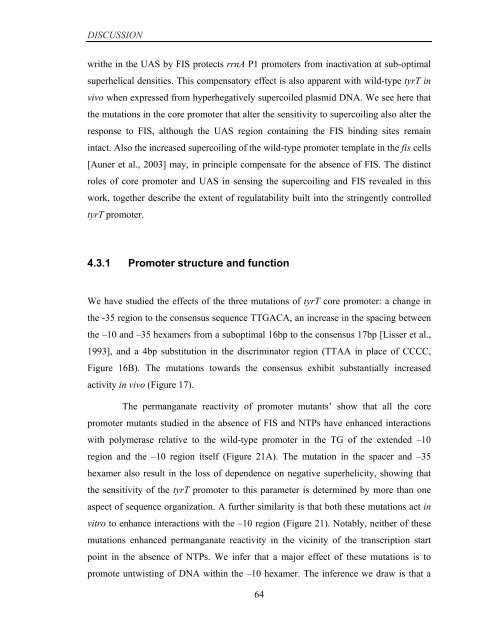Coordinated regulation of gene expression by E ... - Jacobs University
Coordinated regulation of gene expression by E ... - Jacobs University
Coordinated regulation of gene expression by E ... - Jacobs University
You also want an ePaper? Increase the reach of your titles
YUMPU automatically turns print PDFs into web optimized ePapers that Google loves.
DISCUSSION<br />
writhe in the UAS <strong>by</strong> FIS protects rrnA P1 promoters from inactivation at sub-optimal<br />
superhelical densities. This compensatory effect is also apparent with wild-type tyrT in<br />
vivo when expressed from hyperhegatively supercoiled plasmid DNA. We see here that<br />
the mutations in the core promoter that alter the sensitivity to supercoiling also alter the<br />
response to FIS, although the UAS region containing the FIS binding sites remain<br />
intact. Also the increased supercoiling <strong>of</strong> the wild-type promoter template in the fis cells<br />
[Auner et al., 2003] may, in principle compensate for the absence <strong>of</strong> FIS. The distinct<br />
roles <strong>of</strong> core promoter and UAS in sensing the supercoiling and FIS revealed in this<br />
work, together describe the extent <strong>of</strong> regulatability built into the stringently controlled<br />
tyrT promoter.<br />
4.3.1 Promoter structure and function<br />
We have studied the effects <strong>of</strong> the three mutations <strong>of</strong> tyrT core promoter: a change in<br />
the -35 region to the consensus sequence TTGACA, an increase in the spacing between<br />
the –10 and –35 hexamers from a suboptimal 16bp to the consensus 17bp [Lisser et al.,<br />
1993], and a 4bp substitution in the discriminator region (TTAA in place <strong>of</strong> CCCC,<br />
Figure 16B). The mutations towards the consensus exhibit substantially increased<br />
activity in vivo (Figure 17).<br />
The permanganate reactivity <strong>of</strong> promoter mutants’ show that all the core<br />
promoter mutants studied in the absence <strong>of</strong> FIS and NTPs have enhanced interactions<br />
with polymerase relative to the wild-type promoter in the TG <strong>of</strong> the extended –10<br />
region and the –10 region itself (Figure 21A). The mutation in the spacer and –35<br />
hexamer also result in the loss <strong>of</strong> dependence on negative superhelicity, showing that<br />
the sensitivity <strong>of</strong> the tyrT promoter to this parameter is determined <strong>by</strong> more than one<br />
aspect <strong>of</strong> sequence organization. A further similarity is that both these mutations act in<br />
vitro to enhance interactions with the –10 region (Figure 21). Notably, neither <strong>of</strong> these<br />
mutations enhanced permanganate reactivity in the vicinity <strong>of</strong> the transcription start<br />
point in the absence <strong>of</strong> NTPs. We infer that a major effect <strong>of</strong> these mutations is to<br />
promote untwisting <strong>of</strong> DNA within the –10 hexamer. The inference we draw is that a<br />
64
















